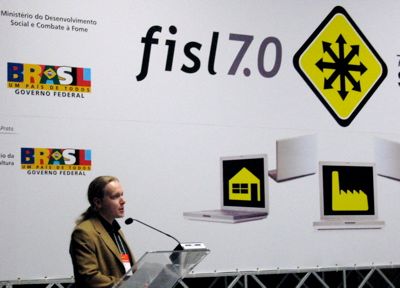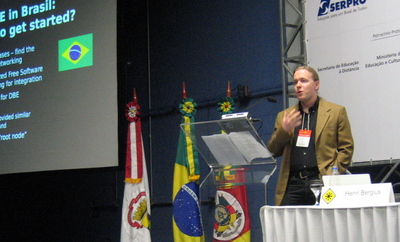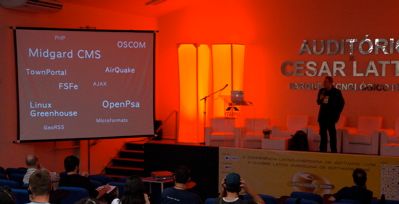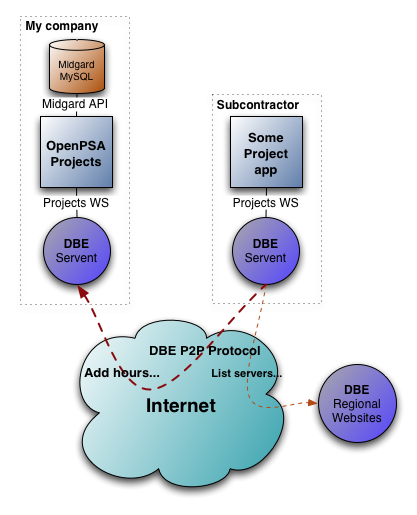Digital Business Ecosystem in FISL

I just finished my Digital Business Ecosystem talk in the 7th International Free Software Forum, Porto Alegre.

Here are the slides, and the transcript of the talk:
Digital Business Ecosystem
- Good morning, everybody! I’m here to talk about Digital Business Ecosystem
- My name is Henri Bergius, I’m from Finland and I’ve been a Free Software
developer since 1997
- I’ve been involved in several projects like the Midgard CMS and OpenPsa, a free management software suite. Before these “serious” projects I was also working on some Quake total conversions
- In 2001 I became an entrepreneur when we started Nemein, a Free Software
development consultancy
- We’ve worked with both clients in Europe, and done several development aid projects in Africa and Eastern Europe
HEL/POA
- I’m really happy to be again here in Brazil. Not only because of the reasons apparent from these two photos, but also because you have such an interesting and energetic Free Software community here
- I have been to Brazil once before, when I attended the Forum GNOME event in Curitiba and OpenBeach in Floripa last November
- I would like to thank the organizers of FISL, and also Izabel Valverde for letting me speak here today
DBE in a nutshell
- Digital Business Ecosystem, or DBE in short is a huge Free Software project funded by the European Union
- There are dozens of companies and universities participating. For example, IBM, Sun and Intel have all assigned full-time developers to work on the project
- In addition to the big players, several small companies working on Free Software business applications have been funded to integrate their applications
- DBE project was started couple years ago, and the first running version of the software was released in summer 2005 through Sourceforge
- The reason why European Union started this project is to make local small business more efficient through providing tools for companies to work with each other
DBE components
- The Digital Business Ecosystem software comes in three parts, some of which are running in the background of evere DBE installation, and some that only software developers use
- First of all, there is the Execution Environment, the heart of every DBE installation. It provides a Java Server-Client for running the installed DBE services
- The Execution Environment is based on the Fada network. Fada is a scale-free Peer-to-Peer network for connecting business applications that was originally developed for the tourist industry in Spain
- In addition to the Execution Environment, there is the Evolutionary Environment which provides tools for connecting different services, and analyzing the health of the network
- There are grand plans for the Evolutionary Environment, including automatically finding best suitable business partners and services, but much of this is still experimental artificial intelligence stuff under work
- For developers, there is the Service Factory, a suite of tools built on top of the Eclipse IDE for building services and defining business models and terminologies
Business Ecosystem example
- Ok, so what exactly is a business ecosystem?
- Here I’m showing a simple example of a business ecosystem: the connections between a car rental company and its partners
- White lines are services offered by a business, and red lines are services used by a business
- The car rental company provides services like car rental and valet parking to hotels
- And it consumes services like repairs from mechanics, advertising services, and accounting services
- So as you can see, even a relatively simple small business has connections with many different services and companies
Why do we need a Digital Ecosystem?
- So why is DBE needed. Why do we need a digital ecosystem anyway?
Connections1
- All business is connections between people. It is connections between different companies
- Now most of these connections happen over telephone, in meetings and especially using the big business integrator: email
- Now, how many of you receive too much email?
Connections2
- But the big issue is that business software doesn’t connect. You can’t take your CRM system and share a client contact with your partners, or automatically collect bids from ten print shops in Porto Alegre for these conference t-shirts
- So, you’re left with browsing web sites, sending lots of email, faxes and making telephone calls. This is time consuming if you’re trying to find the best suitable partner from a collection of dozens of different companies
- DBE could help here by providing a common infrastructure for different business applications to communicate with
Laptop1
- In the past there have been several initiatives for enabling business software to connect. EDI, Web Services and BizTalk come to mind.
- None of these have really taken off yet. The big problem is that they all rely on statically defined connections and interfaces between companies
- Static connections work well when you’re doing the same, well-defined things with same partners all the time over years
- But they don’t work so well in a constantly changing business environment where partners and procedures and terminologies change
Laptop2
- However, most of the business done in the world is done by small businesses. These are businesses that don’t have IT departments, don’t have server infrastructure, and might actually be constantly on the move, changing from network to another, from supplier to another, and from business procedure to another
- For them the statically defined world of Web Services isn’t enough. They need to be able to set up connections quickly and automatically with partners using different technologies, different levels of infrastructure, and different terminology
- Here DBE can again help. The Fada network used in DBE can set up connections between companies automatically regardless on what network they’re on at the moment. And the ontology system of DBE’s evolution environment helps to connect different terminologies with each other.
Free Software opportunity
- Fixing these problems could be a major opportunity for the Free Software movement
- The big proprietary software vendors with their established business models have hard time collaborating with each others
- But for us, collaboration is the natural way of working. No Free Software project can be successful without collaboration
- If we make our software talk with each other, we can easily leapfrog the competition, and provide a benefit proprietary software will have difficulties to beat. But this means different projects must talk with each other.
- Initiatives like the Freedesktop.org project have proven cross-project collaboration is possible

DBE in Brazil
- So how can you get started with DBE here in Brazil?
- First of all, it would be important to find the local business cases, find the “low hanging fruit” that would really benefit from more efficient connections and communications
- Then recognize what Free Software applications they are or could be using, and find out how those could be integrated. And then simply integrate them to the DBE network
- Of course, training would probably be needed. We’ve been running some training sessions for software developers interested in integrating their applications with DBE in Finland
- In Europe the initial such efforts have been funded by the European Union to get the ball rolling.
- Here in Brazil it could happen with regular funding from customers, or the government could get involved
Microenterprise and globalization
- The reason for government to get involved is to support the local small business, or “microenterprise”
- In globalizing world, huge corporations can move their operations easily to wherever it is most beneficial at the moment. To China, to India, to Vietnam, causing huge problems with unemployment.
- But small businesses are relatively local, and loyal to the area they’re working in. Their revenues stay in the local economy, boosting it, and they generate local employment
Small companies adapt faster
- In addition to keeping the money closer to home, an ecosystem of small companies also boosts the economy by being faster to adapt to changes than big corporations can be.
- And big number of small businesses is much safer than few huge ones. Sometimes a business fails, but if it only employs some dozen people it doesn’t yet ruin an economy. And if the local business ecosystem is strong, these people will quickly find new employment or start companies of their own
WSIS 2005
- Here’s a picture I received just before my previous DBE presentation in Curitiba last November
- It seems that the Brazilian government is at least aware of the DBE project to some degree, and seems supportive of its goals
- So maybe government support is coming. But even then, if I were you, I’d start looking for potential applications and businesses to integrate with the Digital Business Ecosystem
- It can be a challenging project, but it can also bring good money, and be lots of fun too
Finally
- So, finally…
Try DBE in practice
- If you want to try out DBE in practice, there is an application called OpenPsa
- It is a Free Software project management and CRM suite that enables consultants to share tasks and work reports across the DBE network
Networked project management
- With OpenPsa you can easily collaborate with your partners and subcontractors. Each can use their own servers, their own management tools, but still have access to all the status and billing information about the project
- If you’re interested in OpenPsa, you can get the latest beta release from http://www.openpsa.org
DBE resources
- I’ll be more than happy to talk more about DBE possibilities and OpenPsa after this session
- Here are some links for finding more information about the project
- In the bottom you’ll also find my email address if you have any questions afterwards
Updated 2006-04-21: The Portland Project is another interesting example of cross-project cooperation.

